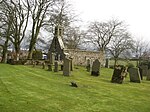Lamington railway station
1848 establishments in Scotland1965 disestablishments in ScotlandBeeching closures in ScotlandDisused railway stations in South LanarkshireFormer Caledonian Railway stations ... and 5 more
Pages with no open date in Infobox stationRailway stations in Great Britain closed in 1965Railway stations in Great Britain opened in 1848Scotland railway station stubsUse British English from September 2020

Lamington railway station served the village of Lamington, South Lanarkshire, Scotland from 1848 to 1965 on the Caledonian main line.
Excerpt from the Wikipedia article Lamington railway station (License: CC BY-SA 3.0, Authors, Images).Lamington railway station
B7055,
Geographical coordinates (GPS) Address External links Nearby Places Show on map
Geographical coordinates (GPS)
| Latitude | Longitude |
|---|---|
| N 55.5597 ° | E -3.6329 ° |
Address
Lamington
B7055
ML12 6GA
Scotland, United Kingdom
Open on Google Maps







